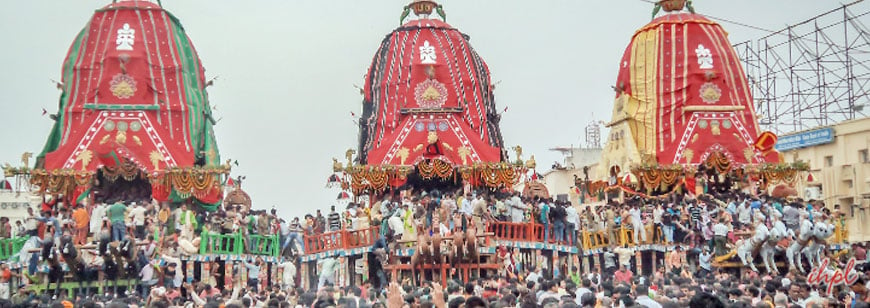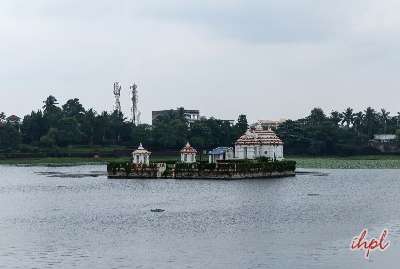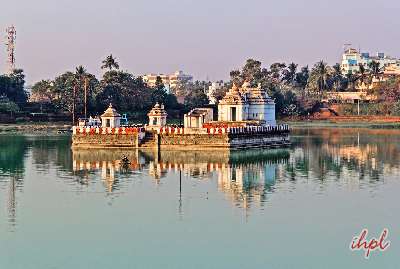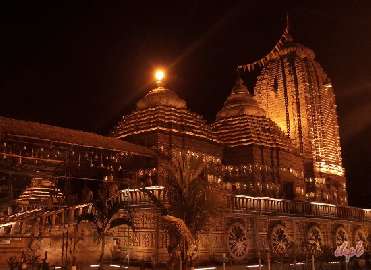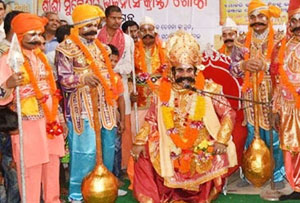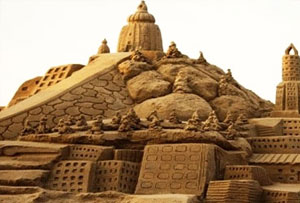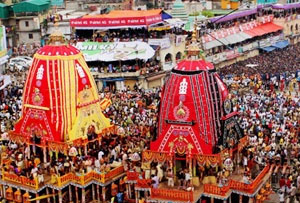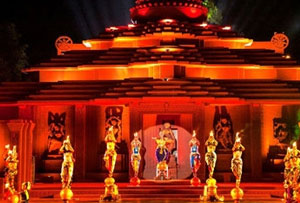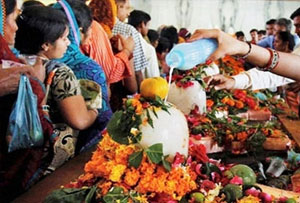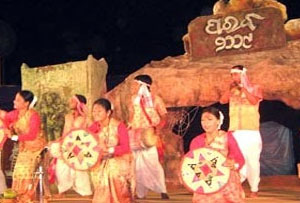Renowned as the Chariot Festival, Jagannath Yatra is one of the most-awaited festivals not only in Odisha but also in the entire country. This annual event is celebrated in the month of June or July. Dedicated to Lord Jagannath (Lord Krishna), his sister Goddess Subhadra, and his elder brother Lord Balabhadra; Jagannath Yatra is a religious procession. It is also called Gundicha Yatra, Car Festival, Dasavatara, and Navadina Yatra.
It is the oldest Rath Yatra taking place in India and in the world. Jagannath Yatra is celebrated on the second day of the Shukla Paksha as per the traditional Oriya calendar. This auspicious festival is celebrated for nine days in Odisha. The festival commences with the Rath Yatra and concludes on a ninth day with a return journey – Bahuda Jatra. During Bahuda Jatra the Rathas visit the Mausi Maa Temple. The deities are moved from their abode of Jagannath Temple to Gundicha Temple during the procession.
On the first day of the procession, the Raths of the deities reach the Gundicha Temple and remain there for the next seven days. And on the ninth day, they return to the Jagannath Temple. The three chariots are constructed and decorated for the deities to start their Yatra. The chariot of Lord Jagannath is called Nandighosa, which is 45.6 feet high with 18 wheels. Lord Balabhadra’s chariot is known as Taladhwaja, which is 45 feet high with 16 wheels. Devi Subhadra’s chariot is known as Dwarapadalan, which is 44.6 feet high with 14 wheels.
All the chariots are pulled by devotees with the help of ropes to the Gundicha Temple, which is situated 3 km from Jagannath Temple. This festival is the perfect depiction of the rich cultural and traditional heritage of the region.
Explore: 7 Days Odisha Tour Package, 5 Days Odisha Tour, 4 Days Odisha Tour From Mumbai, Odisha Tour Package from Bangalore, Golden Triangle of Odisha
History and Legends of Rath Yatra
Jagannath Puri Rath Yatra is believed to be the oldest religious procession in the world. This annual ceremonial procession marks the beginning of the 9-day long festival. There are various legends associated with the Jagannath Yatra. All involve Lord Jagannath who was an incarnation of Lord Vishnu and his siblings Subhadra and Balabhadra or Balaram.
According to one legend, the Jagannath Yatra symbolizes the journey of Lord Jagannath from Vrindavan to Mathura to slay his evil uncle Kansa. Another legend states that the siblings have just recovered from a severe fever and wish to visit their aunt Gundicha for a celebration. And the third legend states that this is an occasion when Lord Jagannath wants to step out to mingle with his devotees.
This festival holds a special significance in Hinduism as the Rath Yatra is a mass movement for enlightening people about the Krishna consciousness movement. It is believed that taking part in the Rath Yatra takes you one step ahead towards self-realization. This festival allows devotees to serve god. It is also assumed that those who pull the chariot rope and also help others in doing so or merely touch the ropes get the advantages of several penances.
The Chariots in Ratha Yatra
The prime attractions of the Rath Yatra of Jagannath are the Chariots. On the day of Akshaya Tritiya, the preparation of the chariots starts. There are 3 main chariots, hand-pulled with 50 meters long ropes. The artists decorate these chariots in a beautiful manner with designs, motifs, and paints.
As the procession starts, the chariot of Lord Balram is pulled, followed by Goddess Subhadra, and that of Lord Jagannath at last. The distance between the two temples is just 3 km but the whole enthusiasm of the tourists and the devotees clubbed with chants and drum beating, takes a few hours. For the 9 days, devotees can seek the blessings of the Lords and the Goddess. The return Yatra halts at the Mausi Maa Temple. Here the deities are served Poda Pitha, a sweet pancake. It is believed that this pancake is the poor man’s food and the Lord is fond of it.
Jagannath Rath Yatra or the Chariot festival is known to be one of the grandest procession festivals. It also finds its mention in Puranas of Hinduism such as Padma Puran, Brahma Puran, and Skanda Purana.
Procession during Rath Yatra
The three deities are fashioned with wood, clothes, and raisins, unlike the ornate and carefully crafted metal idols. During the procession, the Raths are accompanied by chants and conches, which can be heard all around. Before the Yatra commences, the idols are bathed with 109 buckets of water, which is Snana Purnima. These are then placed in isolation till the day of procession, as it is believed that they got fever after taking bath. This event is called Ansara.
On the day of the procession, the holy ritual of Chhera Pahara is performed by the royal successor of Odisha. At this time, hordes of locals and devotees flock around the temple area. During Chhera Pahara, the deities are brought from the temple by the King and are placed on the chariot. Before keeping them, the royal successor sweeps the chariot with a broom that has a gold handle. He later decorates the chariot with flowers. The ground on which the chariot will move is also cleaned by him, after which sandalwood is sprinkled on it.
Through this ritual, it is proposed that everyone is equal to the Lord Jagannath. The temple is accessible only by Hindus but on the day of the Rath Yatra, people of all faiths can visit the temple. The 3 deities remain at the Gundicha Temple, their aunt’s place for a span of 7 days. Later, they are back to their home during the Bahuda Yatra.
On reaching the Jagannath Temple in the evening, they wait outside. On the next day, the idols are adorned with new clothes as babies. This event is called Suna Vesa. After this day, the deities are placed again into the sanctum sanctorum, marking an end to the Rath Yatra of Jagannath Puri.
Where Jagannath Rath Yatra is celebrated?
Jagannath Rath Yatra is celebrated in Puri, which is situated 60 km from Bhubaneswar, the capital city of Odisha. The deities of Lord Jagannath, Lord Balabhadra, and Devi Subhadra reside in the Jagannath Temple, which was built in the 12th century AD by Chodaganga Deva of the Ganga Dynasty.
Rath Yatra 2024
This year, the very popular Jagannath Rath Yatra will be held in July. The festival is celebrated on the 2nd day of the Shukla Paksha, Ashadh month according to the traditional Oriya Calendar. On this day, the chariot will be drawn by hundreds of devotees.
Dress Code for Jagannath Yatra
There is no particular dress code for Jagannath Yatra, however, it is advisable to wear traditional clothes during the procession. Cover yourself completely and respect the religious feelings of the locals.
What to expect in Jagannath Puri Rath Yatra?
This is one of the most-awaited and grandest festivals in Odisha. Jagannath Rath Yatra attracts almost 4 to 5 lakh pilgrims every year from all over the world. Here are some of the highlights of Jagannath Puri Yatra:
- This festival is celebrated for nine days, during which Lord Jagannath and other two deities visit the Gundicha Temple and Mausi Maa Temple.
- The highly decorated chariots resemble the grand temple structure that is pulled through the streets of Badadanda in Puri.
- On this day, non-Hindus and foreign devotees can visit the Jagannath Temple and catch the glimpse of deities, which are otherwise not allowed in the temple.
- The huge procession is accompanied by devotional songs played on drums, trumpets, and other instruments, making the procession a vibrant affair.
Timings of Jagannath Puri Temple
Jagannath Temple opens from 5:30 AM to 10 PM all days of the week.
Interesting Facts about Jagannath Rath Yatra
The popular chariot festival is one of the most spectacular and highly significant events that carry a lot of cultural, religious, and social significance. Here are some of the interesting facts about the Jagannath Rath Yatra:
- Every year, the new chariots are constructed before the Yatra and as many as 1,400 carpenters build the chariot from scratch. All the chariots are built with precision without using the measuring tapes, by using the ancient technique of measurement from hands and fingers.
- The festival is known to have received rainfall every year on the day of the procession. As per the data, there has not been a single Rath Yatra without rainfall.
- The word “juggernaut” in English is derived from the word Jagannath because of the heavy and huge chariots of Lord Jagannath. The word was coined by Britishers during colonial rule when they saw the procession.
- The chariots look like temples and the top of the chariots replicates the structure of North Indian style.
- For making the canopies of the chariots, about 1,200 m of clothes are used and a team of 15 skilled tailors makes the canopies.
- As per the traditions, the royal successor of Puri sweeps the floor of the chariot before the starting of the procession.
- It is believed that the chariot of Lord Jagannath refuses to move at first regardless of how many people are pulling it. According to the local folklore, it is after only a few hours of the festivities and rituals, the chariot starts moving.
Places to visit near Jagannath Temple
Puri is dotted with several attractions for its visitors. Various beaches and temples are here. Some of the popular places to visit near Jagannath Temple are:
- Puri Beach
- Konark Temple
- Konark Beach
- Raghurajpur artist village
- Chilika Lake
- Sakshi Gopal temple
- Pipli village
- Shree Loknath temple
- Gundicha Temple
How to Reach Jagannath Temple
By Air
The nearest airport from the temple is Biju Patnaik Airport, Bhubaneswar, which is situated 60 km from the temple. You can rent a cab or board a bus for Puri. This airport is well-connected with important cities of India such as Delhi, Nagpur, Mumbai, Kolkata, Hyderabad, Visakhapatnam, and Chennai.
By Rail
Puri is the last stop on the East Coast Railway. It is connected through direct express and other super-fast trains with important Indian cities such as Delhi, Tirupati, Kolkata, Mumbai, and Ahmedabad.
By Road
Puri is easily connected through a good network of roads. The bus stand of Puri is located near the Gundicha Temple, which is well connected from Bhubaneswar, Konark, Cuttack, Kolkata, and Visakhapatnam with government-run buses and private buses. You can hire a cab or drive on your own from the nearby cities.
Checkout: Odisha Tour Packages, Gopalpur Tour Packages, Bhubaneswar Tour Packages
Accommodation options near Jagannath Temple
Jagannath Temple is situated in Puri and is one of the popular pilgrimage sites in the country. There are plethora of places to stay near the temple. The Jagannath Temple administration also provides online booking for its guesthouses. Here are some of the popular places to stay near the Jagannath Temple:
- Niladari Bhakta Niwas
- Shri Gundicha Bhakta Niwas
- Nilachala Bhakta and Yatri Niwas
- Madhusmruti
- Mayfair Heritage
- Mayfair Waves
- Chanakya BNR Hotel
- Hotel Golden Tree
- Jamindars Palace
Where to Eat Near Jagannath Temple
There are a lot of restaurants and places to eat near Jagannath Temple that provide some mouthwatering cuisines. Some of the popular places to eat near Jagannath Temple are:
- Agarwal’s Pure Veg Restaurant
- Mamani Restaurant
- Bhojohori Restaurant
- Rasoi Restaurant
- House of Rice
- The Grand

